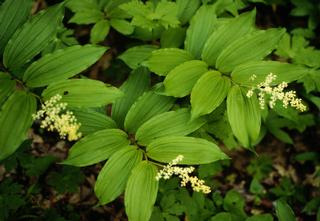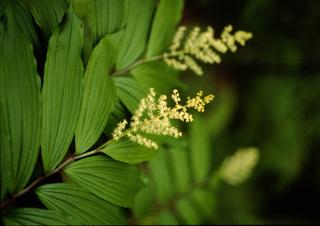 Smilacina racemosum, Wild Spikenard Photograph by John Pickering |
Author: D. Ryan Pahl Ecology Student |
 Smilacina racemosum, Wild Spikenard Photograph by John Pickering |
 Smilacina racemosum, Wild Spikenard Photograph by John Pickering |
Author: D. Ryan Pahl Ecology Student |
 Smilacina racemosum, Wild Spikenard Photograph by John Pickering |
Index:
| Common Names | Higher Taxa | Identification | Geography |
| Natural History | How to Encounter | Medicinal Uses | References |
False Solomon’s Seal
False Spikenard(7)
Wild Spikenard(4)
Division :
Anthophyta
Class : Monocotyledones
Order : Liliales
Family : Liliaceae
(Click link for Family
page)
Subfamily : Smilaceae
(alternate family)
Tribe : undetermined
Genus : Smilacina
(Click link for Genus page)
Species : racemosum
| "Smilacina racemosum is a broad-leafed perennial herb that comes from a underground rhizome."(6) "The rhizome is thick and knotted."(1) "The stems are erect or usually stiffly arched and range in height from 1 to 3 feet tall."(6) "The stems grow in a slight zig-zag fashion."(7) "The showy, broad, elliptical leaves are about 3 to 8 inches long."(6) "The leaves are oval and pointed."(8) "They alternate along the stems in two rows with strong parallel veins."(1) "Each stem may contain anywhere from 5 to 12 leaves."(1) |  |
| Back to Index | Sketch courtesy of Henry Art |
| "The numerous, small creamy white flowers form a panicle at the end of the stock. They are very showy and strongly perfumed."(6) "The star-shaped flowers are clustered in a 6 to 12 inch long cluster at the end of the stem."(1) "Each of the .25 inch flowers has 6 petal-like parts."(1) "The flowers are made up of 3 petals and 3 sepals of the same size and color, forming a cup-like corolla."(3) "The flower also contains 6 stamens and 1 pistle."(3) "The white flowers develop into red berries which may be conspicuous in the fall."(9) |  |
| Back to Index | Sketch courtesy of H. Art |
| "The fruit is a berry containing 1 to 2 seeds."(1) "The fleshy, round berries that are about .125 to .5 inches across are red, but sometimes dotted with purple."(6) "The red color of the berries begins as blotches which expand and eventually the berry becomes an even color at maturity."(6) "The berries are sweet smelling and edible, but not especially palatable."(6) |  |
| Back to Index | Sketch courtesy of H. Art |
"The growth of Smilacina racemosum ranges from Quebec to British Colombia and southward to Virginia, Tennessee, and Missouri, and in the mountains of Georgia."(5) The perennial is not only native to North America, but also to the Himalayas and eastern Asia, including Japan.
Smilacina racemosum |
||||||
| Area | Status | References | Area | Status | References | |
| North America | Yes | Art, 1986 | Blueridge Mnts. | Yes | Art, 1986 | |
| Eastern N. America | Yes | Art, 1986 | Ridge and Valley | Yes | Art, 1986 | |
| Southeast America | Yes | Art, 1986 | Cumberland Plat. | Yes | Art, 1986 | |
| Coastal Plain | Yes | Art, 1986 | Georgia | Yes | Art, 1986 | |
| Piedmont | Yes | Art, 1986 | Clark County, Ga. | Yes | Art, 1986 | |
 |
 |
Diagram courtesy of Coile and James |
Diagram courtesy of Henry Art |
"Smilacina racemosum can be found in moist to dry woods, most often in rich beech-maple stands."(9) "Not only can it be found in moist, open woods containing deep, rich soil, but sometimes in the thin soiled hillsides where there is sufficient moisture. It often thrives in open second-growth stands."(9)
Smilacina racemosum is abundant in the southeastern states starting in the mountains of nothern Georgia. It is found on the forest floor throughout the mountains of Georgia. The perennial was obsevered in the mountains of North Carolina in Joyce Kilmer Memorial Park. The best time to locate Smilacina racemosum is in the springtime when the flowers are in bloom.
Smilacina has been known to be used for medicinal purposes. "Some of the uses for the perennial are a root tea used for constipation and upset stomach and also as a leaf tea to ease coughs."(7) "The leaf tea can also reduce itching and rashes if applied topically."(7)
1. Art, Henry. A Garden of Wildflowers. Storey Communications, Inc. Vermont. 1986. p. 234-5.
2. Coile, Nancy and Samuel James. The
Distrobution of the Vascular Flora of Georgia. UGA Department of
Botany. 1988.
p. 56.
3. Cunningham, James and John Kilmas. Wildflowers
of Eastern America. a Chanticlear Press Edition. New York. 1974.
p.50.
4. Hylander, Clarence. The MacMillan Wildflower Book. MacMillan Company. New York. 1954. p.40.
5. Rickett, Harold. Wildflowers of the United States: The Southwestern States. MacGraw Hill Book Co. New York. p.35.
6. www.audubon.org/chapter/wa/rainier/nn/solomons-seal.html
7. www.ncnatural.com/wildflwr/fsseal.html
8. www.wellesley.edu/Activities/homepage/web/Species/pfalsesolomon.html
9. Voss, Edward. Michigan Flora: Part I - Gymnosperms and Monocots. Kingsport Press. Michigan. 1972. p. 416-9.